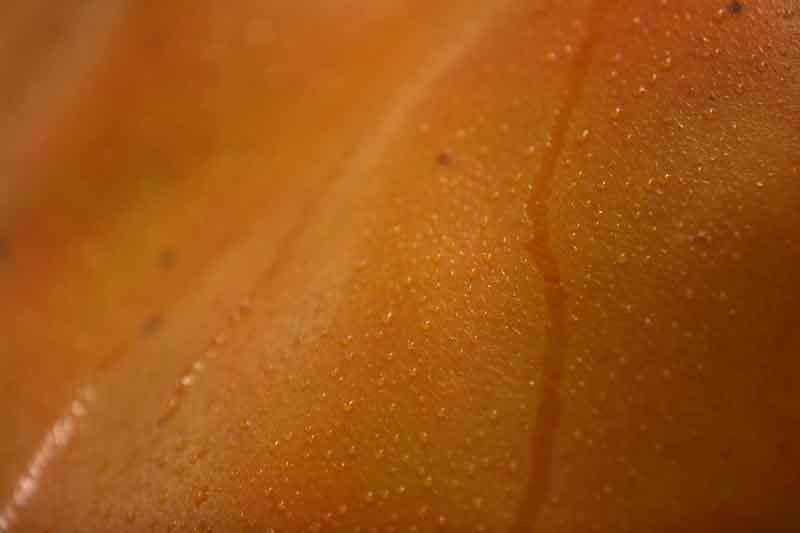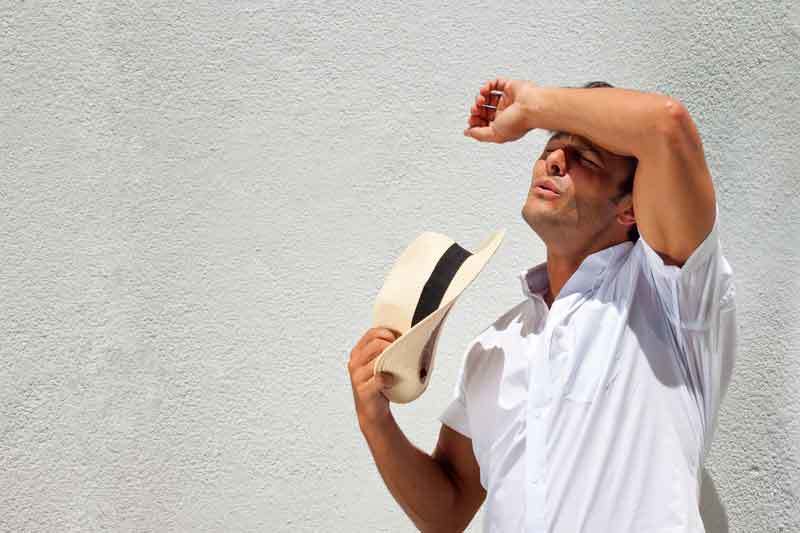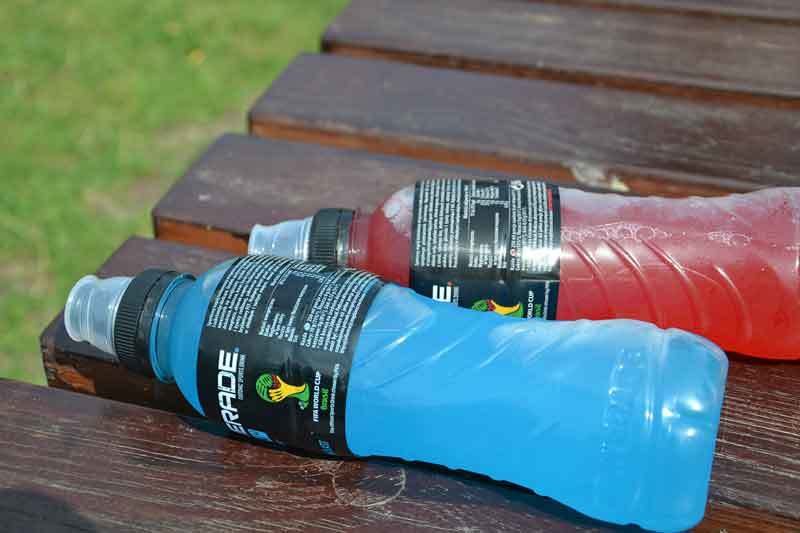Why do people sweat? Do people generally associate a "good sweat" with an effective exercise session? Why do people love to sweat during their workouts? The reasons are varied and many.
From the perspective of fitness instructor, or participant, many of us evaluate the effectiveness of our workout by how much sweat is dripping from our bodies. RPM and group-cycling peeps - I'm looking at you! I know you get satisfaction from those little puddles around your bike.
More...
Excessive sweat creates the image of hard work accomplished and tough exercise. It's the illusion that "if some sweat is good, more must be better." Now, don't get me wrong, sweat is not disgusting. It's a natural, pure, necessary and unavoidable product of exercise. It can be a good thing. But the effectiveness of a workout isn't related to how much sweat is created. In terms of fat loss, total calories burned and cardiovascular conditioning, sweat is irrelevant . What counts is the amount and type of activity that you do, as well as the intensity of the session.
Exercise and muscle contraction depends on taking oxygen into the body. Oxygen uptake is directly related to calorie burning. Calorie burning is related to fat loss and weight control. Sweat isn't a factor. If you consume oxygen, you will burn calories. Since this represents energy production, you will produce heat and sweat to cool the body.
Taking a closer look at sweat

What actually happens when you sweat?
When you exercise, your body produces excess heat as the muscles turn fuel into energy. Your skin plays a key role in keeping you cool. Blood carries the excess heat from deep inside your body to your skin. This allows heat to radiate from your skin's surface. This blood shunt or transfer is shown by a red face flushed skin. Similar to that which occurs on a hot day, our blood vessels dilate to increase blood flow.
Meanwhile, the body perspires, literally dumping water onto your skin. Evaporation of this sweat cools the body. Through perspiration and breathing, both fluid and heat are lost. Since the fluid comes from blood plasma, excess sweating reduces blood volume. As blood supply and volume decreases, the exercising muscles don't perform as efficiently.
If fluids are not replaced, dehydration also adds strain to the heart and circulation. The blood shunt and decreased blood volume will cause the heart rate to increase. It's trying to meet the oxygen needs of the working muscles. A faster beating heart needs more oxygen because it is working harder. In this high stressed situation, oxygen delivery may not be able to meet the oxygen demands of the heart. The skeletal muscles that literally move you can recover from being deprived of oxygen. This is called your oxygen debt and is part of anaerobic metabolism. Unfortunately, the heart muscle does not have the capability to sustain contraction without an adequate oxygen supply. The end result of the body overheating could be a heart attack in susceptible people.
Staying cool during your workout
Even a moderate amount of exercise can bring your core temperature up by a degree or more and produce sweat. Wear loose or 'breathable' clothing which helps your body's cooling system. It will let air flow over your skin; allowing sweat to evaporate. Finally, try to choose a well-ventilated and slightly cool environment. If exercising outdoors, avoid extreme heat and humidity.
The quest for "dripping wet" is counter-productive from a safety and calorie burning standpoint. If it happens, fine - but it shouldn't represent an exercise goal. Simply put, excessive dehydration or heat exposure results in physiological strain on the body and decreased performance. You may produce a lot of sweat as your body frantically tries to cool its core temperature. However, you may end up exercising for a shorter duration, at a lower intensity and the experience may be less than fun.
Bottom line on sweat and exercise
If you exercise in the optimum environment, dress appropriately, take necessary precautions and stay hydrated, you'll burn more calories. Also, you'll be able to exercise harder and longer. Oh yes, plus there is a good chance you'll keep coming back for more!
Exercise physiologists suggest that cooler temperatures may help you perform your best. (You can read a study discussing effects of temperature and exercise here.)
If you feel cool when beginning to exercise, wear an outer garment that is easy to remove once you've warmed up. Temperature is not the sole cause of heat problems. Heat plus humidity (partly influenced by poor ventilation indoors) is even more troublesome. The fact remains that cool and well-ventilated environments provide the best conditions for hard cardiovascular workouts. Class or 'home gym' temperatures may well be warmer than 13 degrees, especially in the summer months. Due to this, it's important not to further increase the temperature and humidity. Avoid turning up the thermostat, closing off ventilation or wearing excessive clothing in order to retain heat.
The exercise environment

The key is to create an environment that is appropriate for the activity in question. It's a balance between exercise intensity, sweat production and comfort. A stretching session will be much different than a high-intensity cardio or strength workout. In a stretching activity, relaxation is as important as actually stretching the muscles. You can't relax in a chilly and drafty environment. In this case, you might want a room that is closer to 21 degrees Celsius (70 Fahrenheit) as warmer temperatures facilitate stretching. Heat build-up as related to performance or physical stress is not a factor for someone who is stretching. In a public facility where you can't quickly raise and lower room temperatures, it's best for a policy which errs on the side of cooler settings. In this situation, participants who are cool can add clothing. If rooms are overheated, few options exist to exercise at optimal conditions.
Though many people can tolerate a hotter and "stuffier" (higher risk) environment, there are issues of liability, safety and enjoyment. Besides not creating the most comfortable conditions to work in from a physical standpoint, many exercisers may have undiagnosed, asymptomatic heart disease or some other ailment. A situation like this puts the person at risk because of the excessive demand it places on the heart. There is competition between the working muscle, the cardiovascular system and the body attempting to cool itself. Competition for blood and fluids. Why would anyone want to jeopardise personal health, not to mention performance?
Sweating for weight loss
What's another reason people want to sweat? To lose weight? Excessively hot environments and layered clothing do promote water loss, and temporary weight loss, through sweating. Likewise, plastic and rubberised 'sauna' suits have the same effect, but can dangerously compromise your cooling system. This can lead to a variety of heat-related injuries or even death. Non-breathable materials don't allow evaporation of sweat and therefore inhibit body cooling.
The reality is that considerable time and effort is required to lose 1kg of body fat. On the other hand, you can lose over a kilogram of water, as measured by the scales, in an hour. Due to this deceiving, instantly gratifying 'weightloss' - many participants are encouraged to or strive to "sweat off the weight." All that you lose is water, and you'll replace it when you begin to drink fluids and eat food. Sounds harmless, but don't forget your performance goes down and you create an 'unpleasant' exercise situation, deemed unsafe by many fitness experts.
You might want to read these other tips I have to help you lose weight.
Men versus Women
Before I sum this up, let's look at the heat regulation between men and women. The fact is that women are generally less prolific sweaters than men. A woman's cooling system likely relies more on blood circulation to transfer heat through the skin, rather than sweating. As a woman's skin and core temperature rise, sweating kicks in. Men make greater use of evaporative cooling. While men and women handle excess heat differently, overall heat tolerance is about the same. It is obvious that the quantity of sweat and onset of sweating isn't a 'measure' for effective exercise.
We should avoid using sweat to determine the level of difficulty of a workout. Avoid promoting dehydration and risk heat-related illness. For years, sweating has been promoted as a means to good health, or to 'purge' the body of 'accumulated toxins.' However, there is little, if any determined relationship between sweating and improved health.
To sweat or not to sweat?
Is it wrong to drip with sweat while you exercise? Good God no! If you exercise at an intensity you've progressively achieved while doing all the right stuff mentioned above...and you still end up dripping wet... good job! Sweating is unavoidable and some people just sweat more than others.
Sports Drinks and Water Intake

Exercise and dehydration
To offset dehydration from sweating and maintain exercise performance, you probably can't drink enough water before and after exercise. As long as you can tolerate it and have the chance to visit the bathroom before you start. To determine if you're taking in enough fluid to match your sweat losses, weigh yourself before and after each workout. Any weight difference will equate to water loss. You should aim to drink 1.5 times this much water (water replenishment isn't a 100% efficient process). For example, if before my session I weigh 69.9kg then afterwards I'm 69.3kg I would be looking to drink 900ml of water over and above my regular daily intake.
If you're drinking enough water, your urine will be pale yellow or almost clear throughout the day. You will also produce copious amounts of it. Different conditions - hot & humid versus cold and dry will require more or less fluid intake. The same is true for exercise intensity and duration.
Sports drinks
Sports drinks are designed to keep or raise, both your fluid and glycogen (carbohydrate) levels to pre-exercise levels. Some drinks also contain electrolytes like potassium and sodium since you lose these minerals when you sweat. Usually, a sports drink isn't required unless you exercise for more than an hour. When exercising for an hour or less, your body primarily needs water - not sugar or minerals. Additionally, a sports drink is probably going to replace most of the calories you burn in a half-hour workout. To competitive athletes, this is not important. However, if one of your main goals is to lose weight, stick with water.
Sports drinks are mainly weak carbohydrate (sugar) solutions. Normally they're around 4-8% sugar and can work well when taken during exercise. Some can be very concentrated (read sweet) and are best taken after exercise, as a recovery drink. There is nothing magical about sports drinks although they can be effective and convenient. You can also dilute soft drinks or juices to the same 4-8% concentration. A proper and balanced diet can provide all of your needs regardless of whether you use a sports drink or not.
Key Point
Training without proper fluid intake does not 'toughen' you up. This habit can simply make you better at exercising when dehydrated and nowhere near your top performance capabilities.
Happy sweating!

